Canadian Nursing Health Assessment 2nd Edition Test Bank
Nursing Test Bank
1 Health Assessment in Nursing Practice
Professional Nursing Practice
Advocacy
Scholarship and Research
Registered Nurse and Advanced Practice Nurse Roles
Purposes of Health Assessment
Wellness and Health Promotion
Health Promotion and Health Assessment
Focused Health History Related to the Case Study
Risk Assessment and Health Promotion
The Nursing Process
Phases of the Nursing Process
Assessment
Analysis
Planning Goals and Outcomes
Planning Care
Intervention/Implementation
Evaluation
Critical Thinking
Clinical Reasoning
Types of Health Assessments
Urgent Assessment
Comprehensive Assessment
Focused Assessment
Priority-Setting
Frequency of Health Assessment
Lifespan Issues
Cultural and Environmental Considerations
Components of the Health Assessment
Documentation and Communication
Organizing Frameworks for Health Assessment
Evidence-Informed Critical Thinking
2 Interviewing and Therapeutic Communication
Communication Process
Nonverbal Communication Skills
Verbal Communication Skills
Active Listening
Restatement
Reflection
Elaboration (Facilitation)
Silence
Focusing
Clarification
Summarizing
Nontherapeutic Responses
Failing to Listen
False Reassurance
Sympathy
Giving Advice
Being Judgmental
Changes of Subject
Distractions
Technical or Overwhelming Language
Interrupting
Professional Expectations
Intercultural Communication
Patients with Limited Language Understanding
Working with an Interpreter
Gender and Sexual Orientation Issues
Phases of the Interview Process
Preinteraction Phase
Beginning Phase
Working Phase
Closing Phase
Lifespan Issues
Newborns and Infants
Children and Adolescents
Older Adults
Special Situations
Patients with Hearing Impairment
Patients with Altered Level of Consciousness
Patients with Cognitive Impairment
Patients with Mental Health Illness
Patients with Anxiety
Patients Who Are Crying
Patients Who Are Angry
Patients under the Influence of Alcohol or Drugs
Personal Questions
Sexual Aggression
3 The Health History
Subjective and Objective Data
Signs and Symptoms
Primary and Secondary Data Sources
Reliability of the Source
Components of the Health History
Date and Time of Health History
Demographic Data or Identifying Data
Reason for Seeking Care or Chief Concern
Present Illness
Pain Goal
Functional Goal
Past Health History
Current Medications and Indications
Family History
Functional Health Assessment
Growth and Development
Review of Systems
Psychosocial and Lifestyle Factors
Social, Cultural, and Spiritual Assessment
Mental Health
Alcohol and Substance Use
Human Violence
Sexual History and Orientation
Lifespan Considerations
Women Who Are Pregnant
Newborns, Children, and Adolescents
Aging Adults
4 Physical Examination Techniques and Equipment
Overview of Anatomical Terms
Anatomical Position
Anatomical Quadrants
Anatomical Regions
Anatomical Terms of Comparison and Movement
Routine Practices and Additional Precautions
Hand Hygiene
Routine Practices
Additional Precautions
Latex Allergy
Skin Reactions
Cultural Considerations
Subjective Data Collection
Objective Data Collection
Promoting Patient Comfort, Dignity, and Safety
Inspection
Palpation
Light Palpation
Deep Palpation
Characteristics of Sound and Sound Transmission
Percussion
Direct Percussion
Indirect Percussion
Auscultation
Advanced Techniques
Lifespan Considerations
Older Adults
Women Who Are Pregnant
Newborns and Infants
Children and Adolescents
5 Documentation and Interprofessional Communication
Patient Health Record
Purposes of the Patient Health Record
Legal Document
Communication and Planning Care
Quality Assurance
Education
Research
Components of the Patient Health Record
Electronic Patient Health Record
Principles Governing Documentation
Confidential
Accurate and Complete
Organized
Timely
Concise
Critical Thinking and Clinical Judgment
Nursing Admission Assessment
Flow Sheets
Plan of Care/Clinical Pathway
Progress Notes
Narrative Notes
SOAP Notes
PIE Notes
Focus Notes
Charting by Exception
Discharge Note
Written Handoff Summary
Verbal Communication
Verbal Handoff
Reporting
Qualities of Effective Reporting
SBAR
Reporting with Other Health Care Professionals
Telephone Communication
Patient Rounds and Conferences
Critical Thinking and Clinical Judgment
Unit 2 General Examinations
6 General Survey and Vital Signs Assessment
Cultural Considerations
Urgent Assessment
Risk Assessment and Health Promotion
Objective Data Collection
Promoting Patient Comfort, Dignity, and Safety
General Survey: General Inspection
Anthropometric Measurements
Vital Signs
Temperature
Pulse
Respirations
Blood Pressure
Vital Signs Monitor
Doppler Technique
Evidence-Informed Critical Thinking
Lifespan Considerations
Older Adults
Infants and Children
7 Pain Assessment
Anatomy and Physiology and Theories of Pain
Gate Control Theory
Nociception: Peripheral Nervous System
Nociception: Central Nervous System
Pain Classification
Duration: Acute Pain
Duration: Chronic (Persistent) Pain
Frequency: Continuous or Intermittent/Episodic Pain
Form: Nociceptive Pain
Form: Neuropathic Pain
Location
Etiology
Association with Cancer
Cultural Considerations
Urgent Assessment
Subjective Data Collection
Assessment of Risk Factors
Health Promotion
Focused Health History Related to Common Symptoms/Signs
Pain Measurement Tools
One-Dimensional Pain Scales
Multidimensional Pain Scales
Special Situations
Patients Unable to Report Pain
Patients with Opioid Tolerance
Objective Data Collection
Equipment
Promoting Patient Comfort, Dignity, and Safety
Comprehensive Physical Examination: Pain
Evidence-Informed Critical Thinking
Clinical Reasoning
Reassessing and Documenting Pain
Lifespan Considerations
Older Adults
Anatomy and Physiology Overview
Subjective and Objective Data
Women Who Are Pregnant
Anatomy and Physiology Overview
Subjective and Objective Data
Newborns, Infants, and Children
Anatomy and Physiology Overview
Subjective and Objective Data
8 Nutrition Assessment
Nutritional Concepts
Primary Nutrients
Carbohydrates
Proteins
Lipids
Vitamins and Minerals
Water
Food, Nutrients, Supplements, and Drug Interactions
Food Safety
Nutritional Guidelines
Types of Reference Values
Canada’s Food Guide
Nutrition Care Process
Collecting Nutritional Data
Sexual Orientation and Gender Identity Considerations
Cultural Considerations
Urgent Assessment
Subjective Data Collection
Assessment of Risk Factors
Risk Assessment and Health Promotion
Focused Health History Related to Nutrition-Associated Symptoms/Signs
Comprehensive Nutritional History
Dietary Assessment Tools
Direct Observation
Objective Data Collection
Promoting Patient Comfort, Dignity, and Safety
Initial Survey and Focused Physical Examination
Evidence-Informed Critical Thinking
Organizing and Prioritizing
Common Laboratory and Diagnostic Testing
Serum Proteins
Hemoglobin and Hematocrit
Lymphocyte Count
Creatinine Excretion
Nitrogen Balance
Skin Testing
Serum Lipid Measurements
Other Laboratory Tests
Clinical Reasoning
Nursing Analysis, Outcomes, and Interventions
Lifespan Considerations
Older Adults
Anatomy and Physiology Overview
Objective Data Collection
Women Who Are Pregnant
Anatomy and Physiology Overview
Objective Data Collection
Infants and Children
Anatomy and Physiology Overview
Objective Data Collection
Adolescents
Anatomy and Physiology Overview
Objective Data Collection
9 Psychosocial and Cognitive Development
Subjective Data Collection
Psychosocial Development
Infant: Trust versus Mistrust
Toddler: Autonomy versus Shame and Doubt
Preschooler: Initiative versus Guilt
School-Age Child: Industry versus Inferiority
Adolescent: Identity versus Role Confusion
Early Adult: Intimacy versus Isolation
Middle Adult: Generativity versus Self-Absorption
Late Adult: Ego Integrity versus Despair
Cognitive Development
Infant: Sensorimotor
Toddler and Preschooler: Preoperational
School-Age Child: Concrete Operational
Adolescent: Formal Operations
Young Adult: Formal Operations
Middle Adult: Cognitive Expertise
Older Adult: Wisdom
Language Development
Cultural Considerations
Urgent Assessment
Objective Data Collection
Physical Growth
Motor Development
Evidence-Informed Critical Thinking
Clinical Reasoning
10 Mental Health Assessment
Mental Health and Psychiatric Assessment in Nursing Practice
Cultural Considerations
Urgent Assessment
Subjective Data Collection
Risk Assessment and Health Promotion
Anxiety
Depression
Suicide
Dementia
Substance Use Problems
Assessment of Risk and Protective Factors
Objective Data Collection
Initial Survey and Mental Status Assessment
Assessment of Dementia, Delirium, and Depression
Evidence-Informed Critical Thinking
Clinical Reasoning
11 Social, Cultural, and Spiritual Health Assessment
Models of Health
Social Assessment
Social Assessment of the Individual
Social Assessment of the Community
Social Assessment at the Societal Level
Cultural Assessment
Characteristics of Culture
Goals of Cultural Assessment
Cultural Health Beliefs and Practices
Cultural Food and Nutrition Practices
Cultural Beliefs and Practices of Pregnancy and Childbirth
Cultural Beliefs and Expressions of Illness and Pain
Spiritual Assessment
Evidence-Informed Critical Thinking
Nursing Analysis, Outcomes, and Interventions
12 Human Violence Assessment
Types of Human Violence
Family Violence
Child Maltreatment
Sibling Violence
Intimate Partner Violence
Elder Abuse
Violence against Adults with Disabilities
Youth and School Violence
“Punking” and Bullying
Workplace Violence
Sexual Violence
Hate Crimes
Human Trafficking
War-Related and Military Violence
Importance of Violence/Safety Assessment
Trauma-Informed Care
Subjective Data Collection
Interviewing Patients about Human Violence
Objective Data Collection
Documentation
Mandated Reporting
Lifespan Considerations
Women Who Are Pregnant
Infants, Children, and Adolescents
Older Adults
Cultural Considerations
Evidence-Informed Critical Thinking
Nursing Analysis, Outcomes, and Interventions
Unit 3 Regional Examinations
13 Skin, Hair, and Nails Assessment
Anatomy and Physiology Overview
Skin
Epidermis
Dermis
Subcutaneous Layer
Hair
Nails
Sweat Glands
Cultural Considerations
Urgent Assessment
Subjective Data Collection
Assessment of Risk Factors
Risk Assessment and Health Promotion
Focused Health History Related to Common Symptoms
Objective Data Collection
Promoting Patient Comfort, Dignity, and Safety
Common and Specialty or Advanced Techniques
Comprehensive Skin Assessment
Lifespan Considerations
Women Who Are Pregnant
Newborns and Infants
Newborns, Infants, Children, and Adolescents
Older Adults
Evidence-Informed Critical Thinking
Organizing and Prioritizing
Common Laboratory and Diagnostic Testing
Clinical Reasoning
Nursing Analysis, Outcomes, and Interventions
14 Head and Neck with Lymphatics and Vascular Assessment
Anatomy and Physiology Overview
The Head
The Neck
Trachea
Thyroid and Parathyroid Glands
Lymphatics
Cultural Considerations
Urgent Assessment
Subjective Data Collection
Assessment of Risk Factors
Health Promotion
Focused Health History Related to Common Symptoms
Objective Data Collection
Promoting Patient Comfort, Dignity, and Safety
Common and Advanced Techniques
Initial Survey
Evidence-Informed Critical Thinking
Organizing and Prioritizing
Common Laboratory and Diagnostic Testing
Clinical Reasoning
Nursing Analysis, Outcomes, and Interventions
Lifespan Considerations
Older Adults
Anatomy and Physiology Overview
Objective Data Collection
Women Who Are Pregnant
Anatomy and Physiology Overview
Objective Data Collection
Newborns and Infants
Anatomy and Physiology Overview
Objective Data Collection
Children and Adolescents
Anatomy and Physiology Overview
Objective Data Collection
15 Eyes and Vision Assessment
Anatomy and Physiology Overview
Extraocular Structures
Extraocular Muscle Function
Intraocular Structures
Vision
Cultural Considerations
Urgent Assessment
Subjective Data Collection
Assessment of Risk Factors
Health Promotion
Focused Health History Related to Common Symptoms
Objective Data Collection
Promoting Patient Comfort, Dignity, and Safety
Common and Advanced Techniques
Assessment of Visual Acuity
Assessment of Visual Fields
Assessment of Extraocular Muscle Movements
Assessment of External Eyes
Assessment of Internal Ocular Structures
Evidence-Informed Critical Thinking
Organizing and Prioritizing
Common Lab and Diagnostic Tests
Lifespan Considerations
Older Adults
Women Who Are Pregnant
Anatomy and Physiology Overview
Objective Data Collection
Newborns, Preschoolers, Children, and Adolescents
Newborns
Preschoolers, Older Children, and Adolescents
Objective Data Collection
16 Ears and Hearing Assessment
Anatomy and Physiology Overview
External Ear
Middle Ear
Inner Ear
Hearing
Air and Bone Conduction
Hearing Disorders
Vestibular Function
Cultural Considerations
Urgent Assessment
Subjective Data Collection
Assessment of Risk Factors
Health Promotion
Focused Health History Related to Common Symptoms
Objective Data Collection
Promoting Patient Comfort, Dignity, and Safety
Evidence-Informed Critical Thinking
Organizing and Prioritizing
Common Laboratory and Diagnostic Testing
Clinical Reasoning
Lifespan Considerations
Older Adults
Women Who Are Pregnant
Newborns, Infants, and Children
Adolescents
17 Nose, Sinuses, Mouth, and Throat Assessment
Anatomy and Physiology Overview
Nose
Sinuses
Mouth
Tongue
Salivary Glands
Teeth and Gums
Throat
Cultural Considerations
Urgent Assessment
Subjective Data Collection
Assessment of Risk Factors
Risk Assessment and Health Promotion
Focused Health History Related to Common Symptoms/Signs
Cultural Considerations
Objective Data Collection
Promoting Patient Comfort, Dignity, and Safety
Common and Advanced Techniques
Comprehensive Physical Examination: Nose, Sinuses, Mouth, and Throat
Cultural Considerations
Evidence-Informed Critical Thinking
Organizing and Prioritizing: Common Laboratory and Diagnostic Testing
Clinical Reasoning: Nursing Analysis, Outcomes, and Interventions
Lifespan Considerations
Older Adults
Anatomy and Physiology Overview
Subjective Data Collection
Women Who Are Pregnant
Anatomy and Physiology Overview
Subjective Data Collection
Newborns and Infants
Anatomy and Physiology Overview
Objective Data Collection
Children and Adolescents
Anatomy and Physiology Overview
Subjective Data Collection
Objective Data Collection
18 Thorax, Lungs, and Respiratory Assessment
Anatomy and Physiology Overview
The Thorax
Anterior Thoracic Landmarks
Posterior Thoracic Landmarks
Reference Lines
Lobes of the Lungs
Lower Respiratory Tract
Upper Respiratory Tract
Mechanics of Respiration
Cultural Considerations
Urgent Assessment
Subjective Data Collection
Assessment of Risk Factors
Health Promotion
Smoking Cessation
Radon Detection in the Home
Prevention of Occupational Exposure
Prevention of Asthma
Immunizations
Focused Health History Related to Common Symptoms
Objective Data Collection
Promoting Patient Comfort, Dignity, and Safety
Common and Advanced Techniques
Evidence-Informed Critical Thinking
Organizing and Prioritizing
Common Laboratory and Diagnostic Testing
Clinical Reasoning
Nursing Analysis, Outcomes, and Interventions
Lifespan Considerations
Older Adults
Anatomy and Physiology Overview
Objective Data Collection
Women Who Are Pregnant
Anatomy and Physiology
Objective Data Collection
Newborns and Infants
Anatomy and Physiology
Objective Data Collection
Children and Adolescents
Anatomy and Physiology
Subjective Data Collection
Objective Data Collection
19 Cardiovascular Assessment
Anatomy and Physiology Overview
Anatomy
Neck Vessels
Heart Chambers
Valves
Heart Wall
Coronary Arteries and Veins
Conduction System
Physiology
Pulmonary and Systemic Circulation
Cardiac Cycle
Jugular Pulsations
Cultural Considerations
Urgent Assessment
Subjective Data Collection
Assessment of Risk Factors and Health Promotion
Smoking Cessation
Control of Blood Pressure and Cholesterol Level
Control of Weight and Stress
Focused Health History Related to Common Symptoms and Signs
Objective Data Collection
Promoting Patient Comfort, Dignity, and Safety
Initial Survey
Auscultation of the Precordium
Extra Sounds
Murmurs
Evidence-Informed Critical Thinking
Organizing and Prioritizing
Common Laboratory and Diagnostic Testing
Clinical Reasoning
Lifespan Considerations
Older Adults
Anatomy and Physiology Overview
Objective Data Collection
Women Who Are Pregnant
Anatomy and Physiology Overview
Objective Data Collection
Newborns and Infants
Anatomy and Physiology Overview
Objective Data Collection
Children and Adolescents
Anatomy and Physiology Overview
Objective Data Collection
20 Peripheral Vascular and Lymphatic Assessment
Anatomy and Physiology Overview
Arterial System
Venous System
Capillaries
Lymphatic System
Fascia Compartments of the Limbs
Cultural Considerations
Urgent Assessment
Subjective Data Collection
Assessment of Risk Factors
Risk Assessment and Health Promotion
Patients with Peripheral Arterial Disease
Patients with Venous Disease
Patients with Lymphatic Disorders
Focused Health History Related to Common Symptoms and Signs
Objective Data Collection
Promoting Patient Comfort, Dignity, and Safety
Initial Survey
Evidence-Informed Critical Thinking
Organizing and Prioritizing
Common Laboratory and Diagnostic Testing
Clinical Reasoning
Nursing Analysis, Outcomes, and Interventions
Lifespan Considerations
Older Adults
Anatomy and Physiology Overview
Objective Data Collection
Women Who Are Pregnant
Anatomy and Physiology Overview
Objective Data Collection
Newborns, Children, and Adolescents
Anatomy and Physiology Overview
Objective Data Collection
21 Breasts and Axillae Assessment
Anatomy and Physiology Overview
Landmarks
Breast Structures
Axillae and Lymph Nodes
Cultural Considerations
Urgent Assessment
Subjective Data Collection
Assessment of Risk Factors and Health Promotion
Teaching the “Know Your Breasts” Approach
Focused Health History Related to Common Symptoms and Signs
Objective Data Collection
Promoting Patient Comfort, Dignity, and Safety
Initial Survey
Evidence-Informed Critical Thinking
Organizing and Prioritizing
Laboratory and Diagnostic Testing
Clinical Reasoning
Nursing Analysis, Outcomes, and Interventions
Lifespan Considerations
Older Adults
Women Who Are Pregnant/Lactating
Newborns and Infants
Children and Adolescents
22 Abdominal Assessment
Anatomy and Physiology Overview
Anatomical Landmarks
Reference Lines
Abdominal Organs
Gastrointestinal Organs
Genitourinary Organs
Blood Vessels, Peritoneum, and Muscles
Ingestion and Digestion
Absorption of Nutrients
Elimination
Cultural Considerations
Urgent Assessment
Subjective Data Collection
Assessment of Risk Factors
Health Promotion
Focused Health History Related to Common Symptoms/Signs
Objective Data Collection
Promoting Patient Comfort, Dignity, and Safety
Initial Survey
Evidence-Informed Critical Thinking
Organizing and Prioritizing
Common Laboratory and Diagnostic Testing
Esophagogastroduodenoscopy
Barium Enema
Colonoscopy
Endoscopic Retrograde Cholangiopancreatography
Computerized Tomography Scan
Magnetic Resonance Imaging
Clinical Reasoning
Lifespan Considerations
Older Adults
Anatomy and Physiology Overview
Objective Data Collection
Women Who Are Pregnant
Anatomy and Physiology Overview
Objective Data Collection
Newborns, Infants, and Children
Anatomy and Physiology Overview
Objective Data Collection
23 Musculoskeletal Assessment
Anatomy and Physiology Overview
Bones
Muscles
Joints
Temporomandibular Joint
Shoulder
Elbow
Wrist and Hand
Hip
Knee
Ankle and Foot
Spine
Cultural Considerations
Urgent Assessment
Subjective Data Collection
Assessment of Risk Factors
Health Promotion
Back Injury Prevention and Occupational Hazards
Lifestyle Considerations
Fall Risk
Bone Density
Psychosocial History
Focused Health History Related to Common Symptoms/Signs
Objective Data Collection
Promoting Patient Comfort, Dignity, and Safety
Advanced Techniques
Comprehensive Physical Examination: The Musculoskeletal System
Evidence-Informed Critical Thinking
Organizing and Prioritizing
Laboratory and Diagnostic Testing
Clinical Reasoning
Nursing Analysis, Outcomes, and Interventions
Lifespan Considerations
Older Adults
Anatomy and Physiology Overview
Subjective Data Collection
Objective Data Collection
Women Who Are Pregnant
Subjective Data Collection
Objective Data Collection
Newborn and Infants
Subjective Data Collection
Objective Data Collection
Children and Adolescents
Subjective Data Collection
Objective Data Collection
24 Neurological Assessment
Anatomy and Physiology Overview
Central Nervous System
Brain
Protective Structures of the CNS
Spinal Cord
Peripheral Nervous System
Cranial Nerves
Spinal Nerves
Autonomic Nervous System
Cultural Considerations
Urgent Assessment
Subjective Data Collection
Assessment of Risk Factors
Health Promotion
Stroke Prevention
Injury Prevention
Reduction of Risk for Seizure Activity
Focused Health History Related to Common Symptoms
Objective Data Collection
Promoting Patient Comfort, Dignity, and Safety
Neurological Assessment in Selected Situations
Screening Examination of a Healthy Patient
Serial Neurological Assessment and Documentation
Assessment of Meningeal Signs
Assessing the Unconscious Patient
Brain Herniation Syndromes
Initial Survey
Focused Physical Examination: Neurological System
Evidence-Informed Critical Thinking
Organizing and Prioritizing
Common Laboratory and Diagnostic Testing
Clinical Reasoning
Lifespan Considerations
Older Adults
Anatomy and Physiology Overview
Objective Data Collection
Women Who Are Pregnant
Anatomy and Physiology Overview
Objective Data Collection
Newborns and Infants
Anatomy and Physiology Overview
Objective Data Collection
Children and Adolescents
Anatomy and Physiology Overview
Objective Data Collection
25 Male Genitalia and Rectal Assessment
Anatomy and Physiology Overview
External Genitalia
Internal Genitalia
Testes
Ducts
Secretory Structures
Rectum and Anus
Rectum
Anal Canal and Anus
Cultural Considerations
Urgent Assessment
Subjective Data Collection
Risk Assessment and Health Promotion
Testicular Self-Examination (TSE)
Screening for Prostate Cancer
Safer Sexual Practices
Protection during Contact Sports
Focused Health History Related to Common Symptoms and Signs
Cultural Considerations
Objective Data Collection
Promoting Patient Comfort, Dignity, and Safety
Focused Physical Assessment: Male Genitalia and Rectal Assessment
Evidence-Informed Critical Thinking
Organizing and Prioritizing
Common Laboratory and Diagnostic Testing
Clinical Reasoning
Nursing Analysis, Outcomes, and Interventions
Lifespan Considerations
Older Adult
Anatomy and Physiology Overview
Objective Data Collection
Infants and Children
Anatomy and Physiology Overview
Objective Data Collection
Adolescents
Anatomy and Physiology Overview
Objective Data Collection
26 Female Genitalia and Rectal Assessment
Anatomy and Physiology Overview
External Genitalia
Internal Genitalia
Vagina
Uterus
Cervix
Fallopian Tubes
Ovaries
Rectum, Anal Canal, and Anus
Hormone Regulation
Cultural Considerations
Urgent Assessment
Excessive Vaginal Bleeding
Abdominal Pain
Bartholin Gland Infection
Pelvic Inflammatory Disease
Ruptured Tubal Pregnancy
Subjective Data Collection
Human Papillomavirus
Risk Assessment and Health Promotion
Human Papillomavirus
Female Genital Mutilation
Focused Health History Related to Common Symptoms/Signs
Objective Data Collection
Promoting Patient Comfort, Dignity, and Safety
Advanced Techniques
Evidence-Informed Critical Thinking
Common Laboratory and Diagnostic Testing
Nursing Analysis, Outcomes, and Interventions
Lifespan Considerations
Older Adults
Women Who Are Pregnant
Newborns and Infants
Children and Adolescents
Unit 4 Special Populations
27 Women Who Are Pregnant
Anatomy and Physiology Overview
Preconception
First Trimester
Second Trimester
Third Trimester
Determining Weeks of Gestation
Role of the Nurse in the Outpatient Setting
Cultural Considerations
Urgent Assessment
Subjective Data Collection
Assessment of Risk Factors
Risk Assessment and Health Promotion
Focused Health History Related to Common Symptoms/Signs in Pregnancy
Objective Data Collection
Promoting the Woman’s Comfort, Dignity, and Safety
Assessment during the Initial Visit
Assessment during Routine Pregnancy Visits
Evidence-Informed Critical Thinking
Common Laboratory and Diagnostic Testing
Nonstress Test
Leopold Manoeuvres
Clinical Reasoning
Plan of Care, Interventions, and Outcomes
28 Newborns and Infants
Anatomy and Physiology Overview
Physical Growth
Motor Development
Language, Psychosocial, and Cognitive Development
Urgent Assessment
Emergent Concerns
Subjective Data Collection
Assessment of Risk Factors
Risk Assessment and Health Promotion
Safe Sleep Habits
Choking
Immunization Schedules
Child Safety Car Seat
Cardiopulmonary Resuscitation Training for Parents
Poison Control
Breast-feeding and Iron-rich Foods
Baby Bottle Tooth Decay
Focused Health History Related to Common Symptoms/Signs
Objective Data Collection
Promoting Patient Comfort, Dignity, and Safety
Comprehensive Physical Examination: Newborn and Infant
Documentation of Examination Findings
Cultural Considerations
Evidence-Informed Critical Thinking
Organizing and Prioritizing
Common Laboratory and Diagnostic Testing
Clinical Reasoning
Nursing Analysis, Outcomes, and Interventions
29 Children and Adolescents
Anatomy and Physiology Overview
Physical Growth
Motor Development
Language
Psychosocial and Cognitive Development
Cultural Considerations
Urgent Assessment
Subjective Data Collection
Important Topics for Health Promotion
Focused Health History Related to Common Symptoms
Cultural Considerations
Objective Data Collection
Equipment
Promoting Patient Comfort, Dignity, and Safety
Developmental Assessment
Evidence-Informed Critical Thinking
Common Laboratory and Diagnostic Testing
Clinical Reasoning
30 Older Adults
Anatomy and Physiology Overview
Skin, Hair, and Nails
Head and Neck
Eyes and Vision
Ears and Hearing
Nose, Mouth, and Throat
Thorax and Lungs
Heart and Neck Vessels
Peripheral Vascular and Lymphatics
Breasts and Lymphatics
Abdomen, Metabolism, and Elimination
Musculoskeletal
Neurological
Male and Female Genitourinary
Endocrine
Immune System
Frailty and Geriatric Syndromes
Cultural Considerations
Urgent Assessment
Subjective Data Collection
Interviewing the Older Adult
Assessment of Risk Factors
Health Promotion
Cultural Considerations
Objective Data Collection
Promoting Patient Comfort, Dignity, and Safety
Comprehensive Physical Examination: The Older Adult
Instruments
Evidence-Informed Critical Thinking
Organizing and Prioritizing
Common Laboratory and Diagnostic Testing
Clinical Reasoning
Nursing Analysis, Outcomes, and Interventions
31 Individuals with Obesity
Demographics of Obesity
Measuring Obesity
Edmonton Obesity Staging System
Contributors to Obesity
Day-to-Day Struggles
Psychology of Obesity
Social Injustice Related to Obesity
Weight Bias
RESPECT: A Model for the Sensitive Treatment of the Bariatric Patient
Anatomy and Physiology Overview
Vital Signs
Pain
Blood Pressure
Pulse
Temperature
Oxygen Saturation
Respirations
Skin
Head and Neck
Torso
Extremities
Genitalia
Endocrine and Metabolic Functioning
Dyslipidemia/Hyperlipidemia
Cultural Considerations
Urgent Assessment
Subjective Data Collection
Assessment of Risk Factors
Health Promotion
Building Self-Esteem and Confidence
Physical Activity
Weight Reduction
Nutrition Assessment
Bariatric Consultation
Medications
Surgical Health-Promoting Options
Gastric Bypass
Vertical Sleeve Gastrectomy
Duodenal Switch
Focused Health History Related to Selected Common Symptoms and Signs
Objective Data Collection
Promoting Patient Comfort, Dignity, and Safety
Comprehensive Physical Examination: The Individual with Obesity
Initial Survey
Physical Examination
Evidence-Informed Critical Thinking
Organizing and Prioritizing
Common Laboratory and Diagnostic Testing
Diagnostic Imaging
Clinical Reasoning
Lifespan Considerations
Older Adults
Women Who Are Pregnant
Children and Adolescents
Unit 5 Pulling It All Together
32 A Complete Health Assessment

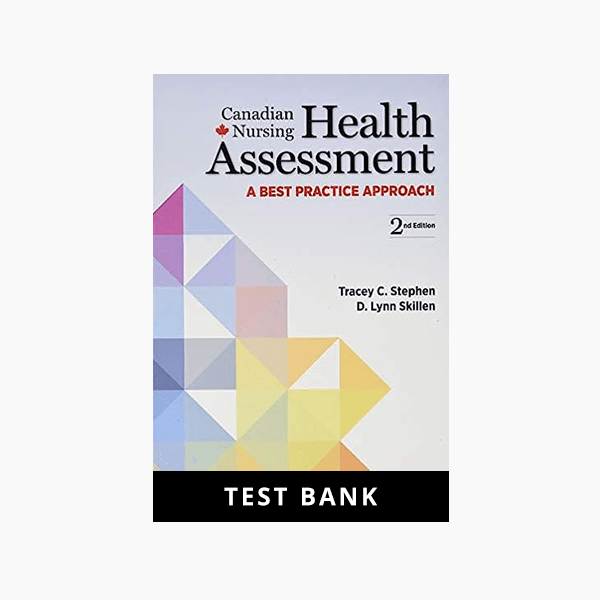




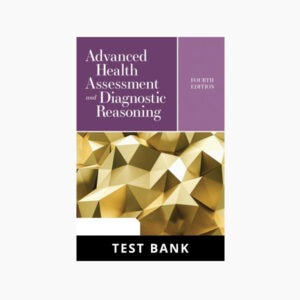
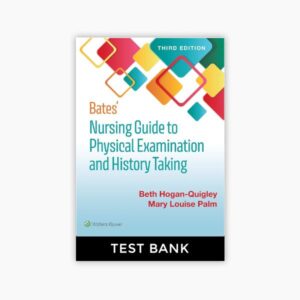
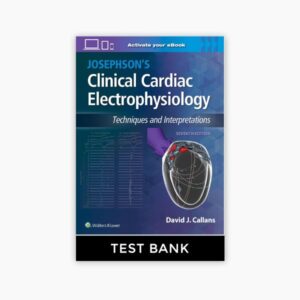
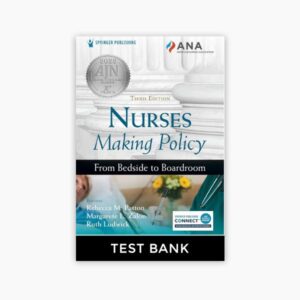
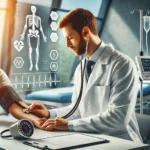
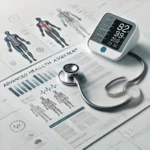
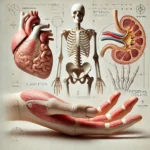




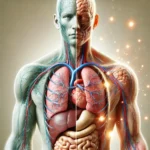


Reviews
There are no reviews yet.